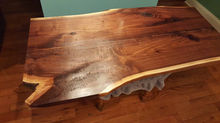Black Walnut Desk Project Result = Proud!
I am wrapping up my latest woodworking/furniture project. Megan bought me two huge pieces of black walnut (expensive and looks great!) for my birthday. As soon as I had them unloaded from the car, my mind was racing with the possibilities and projections of what this wood could look like when it was finished. We decided it would best serve me as a desk for the office to replace the Ikea-esque desk I currently use.

Because this wood is pricey, I wanted to be extra careful and take my time with this desk project. I also wanted it to look really good! Overall this has taken me about 3 to 4 weeks with inconsistent work during that time. I began by removing the bark from the edges that would be "live edge" - meaning you don't cut off the edge in a straight line like you would with a regular desk, but rather you leave it in the same shape it came originally with the slab and simply sand it down. This look is popular and rustic, and also looks really neat and natural.
This process was somewhat arduous, because the bark was pretty well attached to this hardwood species. Apparently, there are some times of year where it should come off easier...but this was not it! I used a wood chisel, a hammer, a wood saw, and pure anger to remove the bark. Once I had the bark removed from the non-cutting sides, I sanded them down as much as possible, leaving a few places with a bit of bark for appearance purposes.
After all the bark was removed I took the slabs back to the lumber yard where Megan purchased them and had them plane the slabs on the top and bottom - about 1/8 to 1/4 inches off of both sides - I could not have done this myself because I don't have a planer (d'oh!) but the slabs were too wide for my father-in-law's planer anyway. I also had them saw one side off of each slab since I was already there. Chattanooga Hardwood is awesome! The slabs were looking pretty good already at that point so I was getting pretty excited about my future desk!
My next step was to sand the slabs on the tops of both pieces, starting with 60-grit, working through to 80, 100, 150 and 220. Hardwood can take a while to sand, so it wasn't perfect, but I knew I would be glueing the pieces together so everything was sanded well enough at that point. I also filled all visible cracks with clear epoxy so that they would be nice and "closed" during shrinkage and expansion of the wood. It happens no matter what, but hopefully the epoxy will minimize the movement. By the way, epoxy is an amazing substance, but kind of intimidating if you don't know what you're doing like yours truly. But I made out ok.
...then I waited. And waited. And waited. Until we went to White House, TN to see the in-laws. I am not always the most patient, so I had been rearing to go for a couple weeks by then. I need to work on my patience - but I just love getting results at my own pace! Admittedly though, I wanted Mark's help and knowledge of woodworking to bolster my confidence with these big wooden mini-investments. We glued the two slabs together and clamped them tightly until the glue began to ooze out of the crack along the length of the slabs. This means it's uniformly bonding and should not leave any slab point unglued. With the weight of the slabs pieces, this is pretty important. I decided not to add any structural support until I figure out what type of legs I will use on the desk.

When I finally got the slabs back to the house, I was chomping at the bit to begin sanding the slab. First I used a belt sander (with a bit of overkill) to even out the two slab lines on the top. Then I went through the progression of grit again, but started at 100, then 150, and 220. The wood was still fairly sanded from before. It felt uniformly smooth across the desk top, much like a baby's butt. If a baby's butt were black walnut and looked like wood grain.
Once the single, glued slab was sufficiently sanded all over, I added three coats of danish oil, which brought out the grain pattern in an amazing way. Check it out below:

Danish oil is really nice by itself, but I knew I would be adding polyurethane to protect and shine up the surface of the slab. I went to my fave Lowe's and grabbed Minwax Wipe-On Polyurethane in the gloss finish. Since this is a workspace desk, I thought that would make the most sense, because reasons.
I applied the wipe-on poly six times (yes, six!) waiting at least 3 hours in between each coat. By the third or fourth coat, I would sand in between each coat with 240-grit sandpaper to remove any bubbles or dust, wipe it down with tack cloth and repeated the process until the sixth time. I don't see it getting much hardcore use, but I want this thing to last through a Donald Trump presidency, at least. Just kidding, a Hillary Clinton one would be preferable and involve less potential for nukes.
As you can see below, the surface is pretty glossy, and looks really neat. I know it's not exactly "clean" all over but that was basically what I was going for, minus the over-aggressive marks from the belt sander which was accidental. Still, I think even that added some nice character and I like how it turned out. The last step, which I will wait a few days to do, is to wax and polish the desk top with Howard Feed-N-Wax, which is all-natural and smells citrus-y. Then, the woodworking portion will be complete, unless I am still not happy with the overall sheen of the table. If I am not I will learn to adapt to and accept a semi-gloss finish instead. Ha. Below is the mostly finished product before metal legs are attached. I hope you like it! -EB














